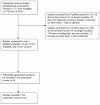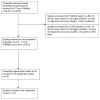Control of visceral leishmaniasis in latin america-a systematic review
- PMID: 20098726
- PMCID: PMC2808217
- DOI: 10.1371/journal.pntd.0000584
Control of visceral leishmaniasis in latin america-a systematic review
Abstract
Background: While three countries in South Asia decided to eliminate anthroponotic visceral leishmaniasis (VL) by 2015, its control in other regions seems fraught with difficulties. Is there a scope for more effective VL control in the Americas where transmission is zoonotic? We reviewed the evidence on VL control strategies in Latin America-diagnosis, treatment, veterinary interventions, vector control-with respect to entomological and clinical outcomes.
Methodology/principal findings: We searched the electronic databases of MEDLINE, LILACS, and the Cochrane Central Register of Controlled Trials, from 1960 to November 2008 and references of selected articles. Intervention trials as well as observational studies that evaluated control strategies of VL in the Americas were included. While the use of rapid diagnostic tests for VL diagnosis seems well established, there is a striking lack of evidence from clinical trials for drug therapy and few well designed intervention studies for control of vectors or canine reservoirs.
Conclusion: Elimination of zoonotic VL in the Americas does not seem a realistic goal at this point given the lack of political commitment, gaps in scientific knowledge, and the weakness of case management and surveillance systems. Research priorities and current strategies should be reviewed with the aim of achieving better VL control.
Conflict of interest statement
Authors declare no competing interest, actual or perceived that could bias the presented work.
Figures
References
-
- Braga RR, Lainson R, Shaw JJ, Ryan L, Silveira FT. Leishmaniasis in Brazil. XXII: Characterization of Leishmania from man, dogs and the sandfly Lutzomyia longipalpis (Lutz & Neiva, 1912) isolated during an outbreak of visceral leishmaniasis in Santarem, Para State. Trans R Soc Trop Med Hyg. 1986;80:143–145. - PubMed
-
- Quinnell RJ, Courtenay O, Garcez L, Dye C. The epidemiology of canine leishmaniasis: transmission rates estimated from a cohort study in Amazonian Brazil. Parasitology. 1997;115(Pt 2):143–156. - PubMed
-
- Courtenay O, Quinnell RJ, Garcez LM, Dye C. Low infectiousness of a wildlife host of Leishmania infantum: the crab-eating fox is not important for transmission. Parasitology. 2002;125:407–414. - PubMed
-
- Travi BL, Jaramillo C, Montoya J, Segura I, Zea A, et al. Didelphis marsupialis, an important reservoir of Trypanosoma (Schizotrypanum) cruzi and Leishmania (Leishmania) chagasi in Colombia. Am J Trop Med Hyg. 1994;50:557–565. - PubMed
-
- Lainson R, Dye C, Shaw JJ, Macdonald DW, Courtenay O, et al. Amazonian visceral leishmaniasis–distribution of the vector Lutzomyia longipalpis (Lutz & Neiva) in relation to the fox Cerdocyon thous (linn.) and the efficiency of this reservoir host as a source of infection. Mem Inst Oswaldo Cruz. 1990;85:135–137. - PubMed
Publication types
MeSH terms
LinkOut - more resources
Full Text Sources





